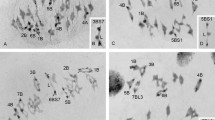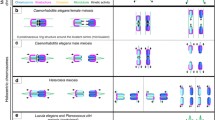Abstract
Three plants of cultivated rye heterozygous for reciprocal translocations have been used to analyze the centromere co-orientation in ring quadrivalent associations at metaphase I. New cytological evidence of the existence of the alternate-II configuration is presented. From the statistical analysis of the data one can deduce that: (i) the four configurations (adjacent-I, adjacent-II, alternate-I and alternate-II) appear with different frequencies, (ii) alternate co-orientations are much more frequent than adjacent ones, (iii) co-orientations of type I are more frequent than those of type II, (iv) among the alternate configurations those of type I are much more frequent than those of type II, (v) among the type I co-orientations the alternate configuration is much more frequent than the adjacent one, (vi) there is no correlation between the percentages of type I and type II classes within the adjacent and alternate co-orientations.
Similar content being viewed by others
References
Akdik, S., Müntzing, A.: New cases of segmental interchanges and some other meiotic irregularities in rye. Hereditas (Lund) 35, 67–76 (1949)
Bajer, A.S., Molé-Bajer, J.: Spindle dynamics and chromosome movements. Int. Rev. Cytol., Suppl. 3 (1972)
Bauer, H., Dietz, R., Röbbelen, C.: Die Spermatocytenteilungen der Tipuliden. III. Das Bewegungs-verhalten der Chromosomen in Translokationsheterozygoten von Tipula oleracea. Chromosoma (Berl.) 12, 116–189 (1961)
Boer, P. de: Male meiotic behavior and litter size of the T(2;8)26H and T(1;13)70H mouse reciprocal translocations. Doctoral Thesis, Landbouwhogeschool, Wageningen 1975
Burnham, C.R.: Chromosome segregation in translocations involving chromosome 6 in maize. Genetics 35, 446–481 (1950)
Burnham, C.R.: Chromosomal interchanges in plants. Bot. Rev. 22, 419–552 (1956)
Burnham, C.R.: Discussions in cytogenetics. Minneapolis: Burgess Publ. Co. 1962
Candela, M., Lacadena, J.R.: Chromosomal polymorphism by reciprocal translocations, in a natural population of cultivated rye, Secale cereale L.: A preliminary note. Anal. Inst. Bot. Cavanilles 32, 649–657 (1975)
Cochran, D.G.: Disjunction types and their frequencies in two heterozygous reciprocal translocations of Blatella germanica (L.). Chromosoma (Berl.) 59, 129–135 (1976)
Cochran, D.G.: Patterns of disjunction frequencies in heterozygous reciprocal translocations from the German cockroach. Chromosoma (Berl.) 62, 191–198 (1977)
Eicher, E.M., Green, M.C.: The T6 translocation in the mouse: its use in trisomy mapping, centromere localization, and cytological identification of linkage group III. Genetics 71, 621–632 (1972)
Endrizzi, J.E.: Alternate-1 and alternate-2 disjunctions in heterozygous reciprocal translocations. Genetics 77, 55–60 (1974)
Ford, C.E., Searle, A.G., Evans, E.P., West, J.B.: Differential transmission of translocations induced in spermatogonia of mice by irradiation. Cytogenetics 8, 447–470 (1969)
Hrisi, N., Müntzing, A.: Structural heterozygosity in Secale kuprijanovii. Hereditas (Lund) 46, 745–752 (1960)
Hrisi, N., Müntzing, A., Ramulu, K.S.: Further data on structural heterozygosity in a strain of Secale kuprijanovii. Hereditas (Lund) 61, 339–347 (1969)
Hughes-Schrader, S.: Polarization, kinetochore movements, and bivalent structure in the meiosis of male mantids. Biol. Bull. 85, 265–300 (1943)
John, B., Lewis, K.R.: The meiotic system. Protoplasmatologia. Vol. VI F/1. Wien: Springer 1965
John, B., Lewis, K.R.: Chromosome hierarchy. Oxford: Clarendon Press 1975
Lacadena, J.R.: Genética, 2a edición. Madrid: A.G.E.S.A. 1976
Lawrence, C.W.: Genotypic control of chromosome behaviour in rye. VI. Selection for disjunction frequency. Heredity 12, 127–131 (1958)
Lawrence, C.W.: The orientation of multiple associations resulting from interchange heterozygosity. Genetics 48, 347–350 (1963)
Luykx, P.: Cellular mechanisms of chromosome distribution. Int. Rev. Cytol., Suppl. 2 (1970)
Lyon, M.F., Glenister, P.H., Hawker, S.G.: Do the H-2 and T-loci of the mouse have a function in the haploid phase of sperm?. Nature (Lond.) 240, 152–153 (1972)
Müntzing, A., Prakken, R.: Chromosomal aberrations in rye populations. Hereditas (Lund) 27, 273–308 (1941)
Nicklas, R.B.: Chromosome micromanipulation. II. Induced reorientation and the experimental control of segregation in meiosis. Chromosoma (Berl.) 21, 17–50 (1967)
Nicklas, R.B.: Mitosis. Advanc. Cell Biol. 2, 225–297 (1971)
Nicklas, R.B.: Chromosome segregation mechanisms. Genetics 78, 205–213 (1974)
Nicklas, R.B., Koch, C.A.: Chromosome manipulation. III. Spindle fiber tension and reorientation of mal-oriented chromosomes. J. Cell Biol. 43, 40–50 (1969)
Phillips, R.L., Burnham, C.R., Patterson, E.B.: Advantages of chromosomal interchanges that generate haplo-viable deficiency-duplications. Crop Sci. 11, 525–528 (1971)
Rees, H., Sun, S.: Chiasma frequency and the disjunction of interchange association in rye. Chromosoma (Berl.) 16, 500–510 (1965)
Rohloff, H.: Die Spermatocytenteilungen der Tipuliden. IV. Mitteilung, Analyse der Orientierung röntgenstrahleninduzierter Quadrivalente bei Pales ferruginea. Dissertation Universität Tübingen 1970
Searle, A.G.: The determination of centromere position in the mouse by translocation intercrosses. Heredity 23, 629–630 (1968)
Searle, A.G., Ford, C.E., Beechey, C.V.: Meiotic disjunction in mouse translocations and the determination of centromere position. Genet. Res. (Camb.) 18, 215–235 (1971)
Shalev, A., Ladizinsky, G.: The segregation pattern of a translocation quadrivalent. Chromosoma (Berl.) 57, 297–308 (1976)
Sun, S., Rees, H.: Genotypic control of chromosome behaviour in rye. VII. Unadaptive heterozygotes. Heredity 19, 357–368 (1964)
Sun, S., Rees, H.: Genotypic control of chromosome behaviour in rye. IX. The effect of selection on the disjunction frequency of interchange associations. Heredity 22, 249–254 (1967)
Sybenga, J.: Orientation of interchange multiples in Secale cereale. Heredity 23, 73–79 (1968)
Sybenga, J.: General cytogenetics. Amsterdam-London-New York: North Holland/American Elsevier 1972
Sybenga, J.: Meiotic configurations. Berlin-Heidelberg-New York: Springer 1975
Thompson, J.B.: Genotypic control of chromosome behaviour in rye. II. Disjunction at meiosis in interchange heterozygotes. Heredity 10, 99–108 (1956)
Author information
Authors and Affiliations
Rights and permissions
About this article
Cite this article
Lacadena, J.R., Candela, M. Centromere Co-orientation at metaphase I in interchange heterozygotes of rye, Secale cereale L.. Chromosoma 64, 175–189 (1977). https://doi.org/10.1007/BF00327057
Received:
Accepted:
Issue Date:
DOI: https://doi.org/10.1007/BF00327057




